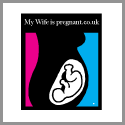Terminology A-Z

Gain understanding of words that you will hear during the course of your partners pregnancy. Impress and educate her by sharing your new found knowledge.
Amniotic fluid:
Protective fluid in the sac surrounding the fetus in the mother’s uterus, this what will stay in until the mothers water breaks and she is ready to give birth.
Amniotic sac:
The sac in which the fetus develops.
Antenatal classes:
Classes to help you prepare you for labour, birth, and early parenthood.
Bracks and Hicks:
Contractions that take place earlier on pregnancy. This term was founded by John Braxton Hicks, an English doctor who first described them in 1872.
Breech:
The position of the baby in the uterus, where it’s feet or buttocks appear first
Caesarean:
A caesarean section, or c-section, is a form of childbirth in which a surgical incision is made through a mother’s abdomen and uterus to deliver one or more babies.
Cervix:
The lower, narrow portion of the uterus that it joins with the top end of the vagina. It remains closed during pregnancy and dilates during labor and delivery to allow the baby to be born.
Contractions:
The tightening and shortening of the uterine muscles during labor causing the dilation of the cervix and contributing to the descent of the baby.
Dilation:
The opening (or widening) of the cervix during labour
Epidural:
An injection given into the lower back, acting as a pain relief during childbirth
Fetus:
A fetus (or foetus or fœtus) is a developing mammal or other viviparous vertebrate, after the embryonic stage and before birth
Induced Labour:
This is where a doctor has to use artificial means to bring on contractions and begin the labor process.
Morning Sickness:
Morning Sickness currently affects more than 70% of pregnant women and is characterized by nausea and vomiting. It can be triggered by an extreme sensitivity to certain smells, usually starting at week 6 and finishing at around about week 16.
Stretch Marks:
Stretch marks are a form of scarring on the skin; they are influenced by hormonal changes associated within puberty, pregnancy, muscle building etc.
Placenta:
The vascular structure in the uterus, providing oxygen and nutrients for and transferring wastes from the developing fetus.
Uterus:
A hollow muscular organ in the pelvic cavity of females; contains the developing fetus



